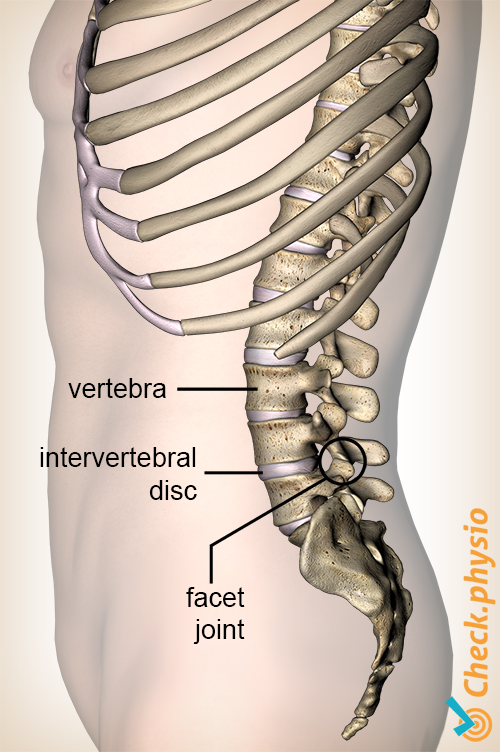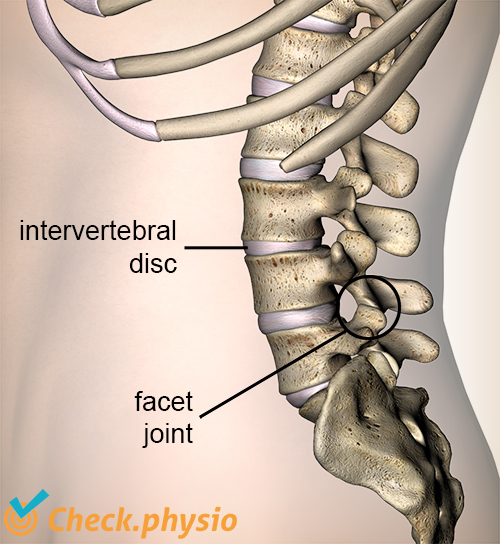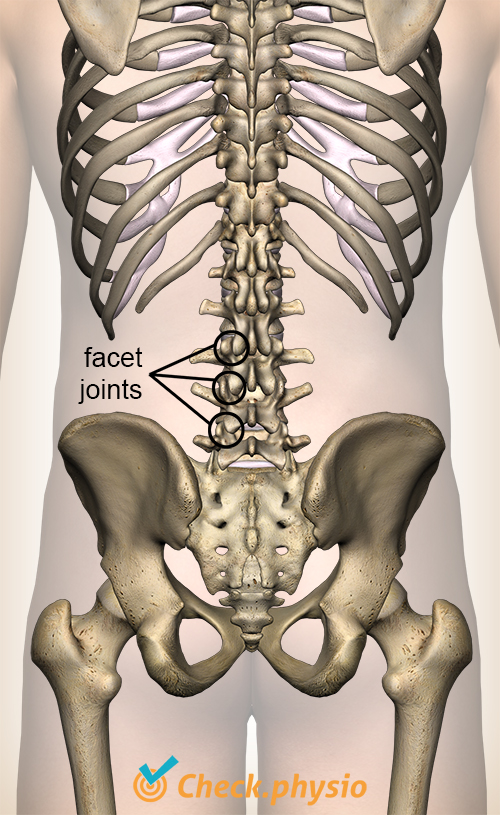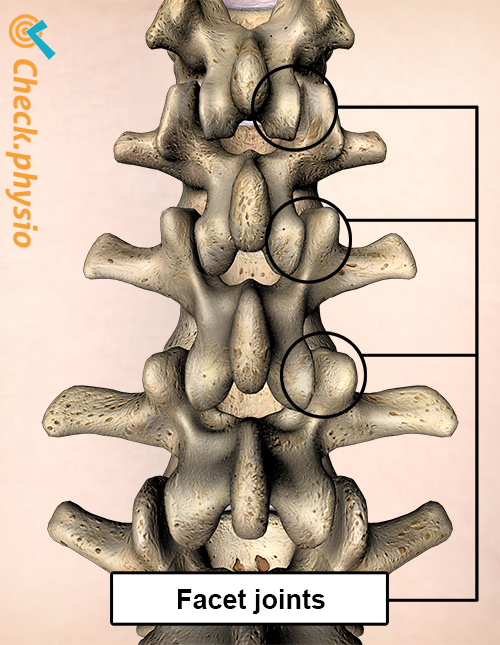- Conditions
- Lumbar facet syndrome
Lumbar facet syndrome Pain in the facet joints of the lower back
Introduction
There are many structures that can cause lower back pain. The facet joints are increasingly being identified as a major cause of lower back pain. The pain can manifest itself in various ways, but is usually on one side radiating to the upper leg.
The lumbar facet syndrome is a collective term for complaints of the facet joints.

Description of the condition
The vertebrae of the back are stacked bony structures that together form the spinal column. The vertebrae are interconnected at the rear by two facet joints. At the front, the vertebrae are connected by means of intervertebral discs.
The facet joints and the intervertebral discs ensure that the vertebrae can move in relation to each other. They also contribute to the overall stability of the back.
Facet joints and intervertebral discs are weight-bearing structures. A lot of forces are exerted on the facet joint particularly when stretching the back.
As a result of wear and tear complaints, which cause the intervertebral discs to become thinner, more forces are exerted on the facet joints. This can make the facet joints irritated and inflamed, which can result in pain.
It is estimated that 15-52% of patients with chronic lower back pain have a problem with the facet joints. However, in only 4% of the cases the facet joints are the sole cause of the complaints. Thus, problems with the facet joints are usually accompanied with disorders of other structures such as intervertebral discs and muscles.
Cause and origin
Lumbar facet syndrome falls under degenerative back pain. This means that degeneration is the main cause. Degeneration refers to the fact that the quality of tissue decreases. This can be caused by the natural ageing process, but also by strain or a changed position of the spine.
As a result of strain or a modified position of the spine (such as scoliosis), the strain on certain facet joints can become too much, which can lead to complaints.
Tissue that is strained, is of reduced quality. Straining is not always the result of heavy work. If the back is always strained in the same way, for example by sitting for a long time, then the strain on certain points is constantly too much, which can lead to strain. This is also the case with non-alternating movement or incorrect use of the lower back and abdominal muscles.
Symptoms of the facet joints can also be caused by trauma. This includes falling backwards or a traffic accident.
Signs & symptoms
Complaints originating from the facet joints can have different characteristics:
- Pain on one side of the lower back (unilateral), sometimes on two sides (bilateral).
- Pain when stretching the back (hollowing out).
- Pain when stretching and turning (looking over the shoulder).
- The pain can radiate to the groin, front, side or back of the thigh.
- Pain when pressure is applied to the lower back.
- The pain often subsides when bending forward.
- Increased muscle tension in the area of the facet joints. In case of unilateral symptoms, therefore, only on one side.
- Running and swimming can provoke the pain.
The area where pain radiates to gives information about the location of the facet problems:
- Radiating pain to the flank and the side of the upper leg can indicate facet problems high in the lower back.
- Radiating pain to the back of the leg indicates more facet problems low in the lower back.
With facet problems there is rarely any radiating pain below the knee. If this is the case, we are more likely to think of problems with an intervertebral disc, such as with a hernia.
Diagnosis
The diagnosis of facet pain is not straightforward, mainly because a combination of causes is often present in chronic back pain. To make the diagnosis, the symptom list and the findings of the physical examination are used.
Pain provocation and the radiating area mainly play a major role in making the diagnosis. During the physical examination, it is checked whether the pain can be provoked from the facet joints.
If necessary, an X-ray guided nerve block procedure can be performed. The pain perception of certain facet joints is temporarily switched off. If this provides relief, the facet joints are involved.
Treatment and recovery
Physiotherapeutic treatment consists of exercise therapy and the application of mobilisation techniques. Pain relief is provided by means of medication. If necessary, muscle relaxants can be prescribed to reduce muscle tension.
As discussed earlier, facet pain is a degenerative disease. For optimal treatment, it is therefore important to examine what might have caused the degeneration. If this is due to a non-alternating posture and non-alternating movement, the treatment will be adjusted accordingly.
If the natural ageing process plays an important role, we will examine how the facet joints can be spared as much as possible. This can be done by guaranteeing the mobility of the joints and by increasing the weight-bearing capacity through exercise therapy.
Exercises
It is important to continue to move in the right way and do exercises for these symptoms. That is why we offer you an exercise programme here with exercises for lumbar facet syndrome.
More info
You can check your symptoms using the online physiotherapy check or make an appointment with a physiotherapy practice in your area.
References
Magee, D.J. (2014) Orthopedic physical assessment Elsevier saunders: St. Louis.
Hestbaek, L., Kongsted, A., Jensen, T.S. & Leboeuf-Yde, C. (2009) The clinical aspects of the acute facet syndrome: results from a structured discussion among European chiropractors Chiropr Osteopat. 2009; 17: 2.



